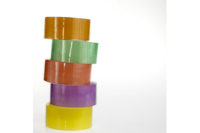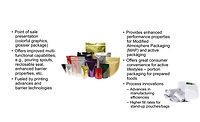New Challenges and Solutions in Converting Packaging Adhesives
Whether they’re running products such as shipping labels, tapes that brand and seal boxes, or pressure sensitives that secure tamper-evident packages, converters benefit from technologies that slash downtime.
.jpg?1650973836)
As the needs of the packaging industry evolve, adhesive converters face new challenges. The recent growth in e-commerce and food delivery services, for example, has converters looking for efficient ways to quickly slit and rewind large rolls of labels and tapes. Demand is also increasing for user-friendly products such as easy-to-remove split liners.
A variety of machinery solutions help converters meet these new requirements. Whether they’re running products such as shipping labels, tapes that brand and seal boxes, or pressure sensitives that secure tamper-evident packages, converters benefit from technologies that slash downtime.
Depending on the application, slitter rewinders can integrate time-saving technologies including dual-unwind configurations, automatic knife cleaning systems, automatic cut transfer systems, and automatic roll unloading systems. Additional solutions cut waste, enable large roll production, and help improve end-user experience.
Converting Labels
Many label converters are going bigger, producing larger finished rolls on their slitter rewinders. Converters traditionally produced finished rolls in the 5,000-10,000-ft range, but some converters are now producing 15,000-, 20,000-, or 25,000-ft rolls with diameters that can reach 40 or 50 in. Rolls can also be wider, with widths to 2 m. While going bigger, label converters are also going faster, generating more output per hour.

A heavy-duty slitter rewinder for label stock produces finished rolls to 50-in. diameters.
Slitter rewinders need a slightly different configuration to quickly handle big-diameter work. Machines must be equipped for large rolls and high production. This is accomplished by integrating specialized designs and features at the unwind, slitting section, and rewind section.
At the unwind, changing master rolls that feed into the slitter can be time consuming. With a conventional setup, depleted master rolls may need to be replaced every 20 min or so. If the machine is down 10-15 min per hour for roll changes, this can really add up over the shift.
A dual unwind setup, however, eliminates this downtime. While one unwind is feeding material into the machine, the other can be loaded with a new master roll. Master rolls can be manually spliced or bumped in with an automatic splice. Using an automatic zero-speed splice, it only takes a short period of time to attach a new roll to the existing web. The machine will come to zero speed for just seconds, and then it’s up and running.
The dual unwind setup can also accommodate very large jumbos. Some converters, for example, use master rolls with 72-in. diameters. Heavy-duty shaftless floor pickup unwinds handle these large masters and allow converters to maximize the footage of finished rolls. The dual unwind setup does require more floor space than a stacked or single unwind, but it also provides significant time savings.
At the slitting section, knife cleaning and knife setup systems also decrease downtime. Wicking systems available for shear and score slitting make it faster and easier to clean adhesive buildup from knives. The latest shear knife wicking system, for instance, automatically cleans male and female blades throughout the roll build process. This eliminates the need to stop the machine after the job for knife cleaning. Slitter rewinders can also be equipped with automatic knife positioning systems for fast, accurate knife setups.

An automatic shear knife wicking system cleans adhesive buildup.
Automated technologies at the rewind provide further time savings. For example, a tray unloading system can automatically remove large, heavy rolls of label stock from duplex center winders. The trays rise up to the finished rolls, strip the rolls off the rewind shaft, and transport the rolls away from the machine so they can be unloaded with a forklift or overhead hoist. Additionally, to reliably handle large, heavy rolls, the rewind section can incorporate specialized features such as high-torque differential rewind shafts and retractable shaft supports.
Salvaging Label Stock Remainders
To achieve even more efficiency, label converters are turning to salvage winders for reworking narrow web rolls. These machines help converters effectively use every inch of material.
Salvage rewinders can reroll otherwise unshippable rolls. In addition, they can also repurpose remainders from slitting rewinding jobs, since many jobs don’t use the entire web width of the master roll when producing finished rolls.
With a salvage winder, converters have the ability to unwind rolls with web widths to 42 in. and rewind new rolls of different lengths and widths. The maximum rewind diameter for new rolls is around 50 in.
Converting Tapes
Like label converters, tape converters want to quickly slit and rewind large rolls of products used in packaging. Among its many impacts, the COVID-19 pandemic has pushed the expansion of e-commerce and restaurant food delivery. In the tape world, this means more tape is being used for applications such as sealing shipping boxes or securing food delivery packages.
Tapes used in shipping include BOPP packaging tapes and water-activated tapes. These tapes often not only seal a package, they also brand it. After slitting and rewinding, packing tapes can go to a printer for name or logo printing. Rolls for this secondary process of narrow web printing are generally large in diameter, which reduces the frequency of downstream roll changes and saves time.
Another growing end use for tapes and pressure sensitives is in tamper-evident packaging. For example, demand for tamper-evident food packaging has increased as delivery services bring more restaurant orders to people’s homes. Both restaurants and consumers want to keep orders intact.
Pressure-sensitive adhesives (PSAs) are used in a variety of ways to show if a package has been opened. Double-sided tape can be secured inside a delivery bag, sealing the bag. Other options include folding printed tapes or labels over a delivery box or bag. As with shipping products, converters of PSAs for tamper-evident packaging want to maximize productivity when producing large rolls.
Specialized duplex center winders are a good choice for running tape. These machines can run at high speeds, up to 2,000 fpm, and typically rewind to 32-in. diameters. The latest models offer some turret productivity technologies along with conventional time-saving technologies.

A duplex center winder for tape offers auto cut transfer, auto unloading systems, and other time-saving features.
Key features keep a slitter rewinder running and boost productivity. These features include automatic cut and transfer, automatic taping at the core for new roll starts, and automatic closure of finished rolls. Automatic knife positioning enables quick size changes, and knife wicking can efficiently remove adhesive buildup from slitting knives. Automatic finished roll discharge systems such as unloading trees and conveyors also reduce downtime.
Improving User Experience
In addition to implementing faster and bigger roll production, converters are taking measures to improve user experience for their end products. For example, converters are increasingly making it easier to peel labels and tapes from a liner.
“Crack and peel” products have a split liner spanning the length of the roll. While peeling labels or tape from an edge can be difficult, a crack and peel liner enables users to bend any portion of the liner so it easily separates from the product.
Meeting Diverse Requirements
Advances in the packaging market place new demands on tape and label stock converters. Recent changes have impacted products such as tamper-evident packaging, shipping labels, and packing tapes.
Many converters now want solutions for fast, large-diameter finished roll production and user-friendly linered products. Slitter rewinders and converting machines with specialized technologies can drastically reduce downtime, cut waste, and effectively meet diverse product requirements.
For more information, visit www.catbridge.com.
Note: Images courtesy of Catbridge Machinery.
Looking for a reprint of this article?
From high-res PDFs to custom plaques, order your copy today!





